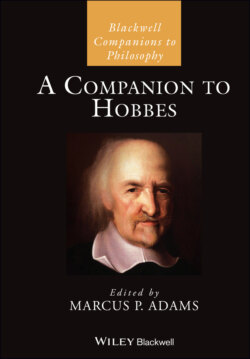Читать книгу A Companion to Hobbes - Группа авторов - Страница 13
2.1 First Philosophy, Mathematics, and Natural Philosophy
ОглавлениеHelen Hattab’s chapter “Hobbes’s Unified Method for Scientia” contrasts Hobbes’s goal of a unified method for theoretical and practical science with his Scholastic predecessors. Hattab shows that Hobbes uses ‘demonstration’ equivocally and argues that this has led scholars to think Hobbes had a single form of method in mind. Hattab argues that in fact, for Hobbes and others, there are two types of method at play: first, a universal method concerned with the ordering of concepts and definitions before one begins the work of discovery or teaching in a subject; and second, a particular method used to demonstrate conclusions. The former method provides principles that are drawn upon in applications of the particular method. However, unlike the differences that Hobbes claimed existed between him and Scholastic Aristotelians, Hattab locates this distinction within Zaberella and shows that it was continued by Keckermann and Burgersdijk, Scholastic Protestant philosophers influential in England during Hobbes’s time.
There has been interest in the Stoic influences upon Hobbes’s political philosophy, but less attention has been devoted to the relationship of Stoic ideas to Hobbes’s first philosophy and natural philosophy. Geoffrey Gorham’s chapter “The Stoic Roots of Hobbes’s Natural Philosophy and First Philosophy” shows how Hobbes’s first philosophy was influenced by Stoic thought and how that influence impacted his natural philosophy, focusing in particular on Hobbes’s views of space, time, causality, and God. These areas of Hobbes’s philosophy were especially pressing for his materialism since they seem to be concerned with incorporeal entities. Indeed, as a result some have attempted to understand Hobbes as an idealist, a subjectivist, or an atheist. Gorham shows that Hobbes’s solution, in line with Hobbes’s goal of providing a materialism that cohered with mechanical philosophy, was to understand the conceptions that grounded first philosophy as having two aspects: realist and subjectivist.
Hobbes’s exalted view of himself as a mathematician did not align with the opinions of his contemporaries. Douglas Jesseph’s chapter “Hobbesian Mathematics and the Dispute with Wallis” examines Hobbes’s philosophy of mathematics and Hobbes’s continual disagreements with John Wallis. Jesseph focuses on Hobbes’s attempts to understand geometrical objects and geometrical definitions in accordance with his materialism and furthermore on Hobbes’s disdain for analytic geometry. Their exchanges relating to mathematics can be seen as originating in 1655 with the publication of De corpore and continuing until Hobbes’s death, and beyond issues in mathematics they also concerned broader issues in theology and politics.
Continuing the focus on the unity of Hobbes’s philosophy begun in Helen Hattab’s chapter, Marcus Adams’s chapter “Explanations in Hobbes’s Optics and Natural Philosophy” examines how Hobbes’s optics and natural philosophy depend upon his geometry. Adams considers Hobbes’s descriptions about how the parts of his philosophy fit together with one another and provides case studies to show Hobbes’s practice of explanation in optics and natural philosophy. Adams suggests that Hobbes held that explanations in natural philosophy should ideally be like those in optics, showing how Hobbes’s explanations in both employ claims from experience and from a priori geometry.
